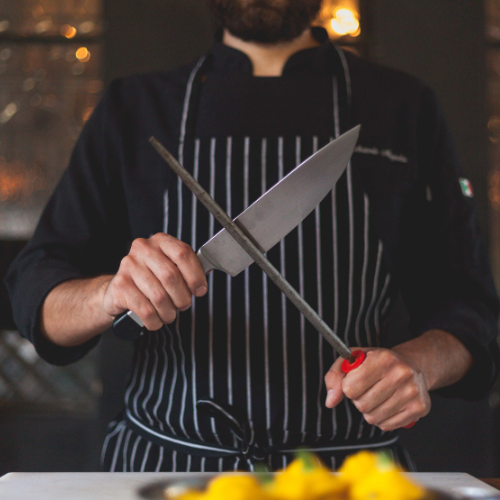A high-quality knife is the cornerstone of every kitchen. Whether you’re dicing vegetables, carving roasts, or slicing fresh bread, the performance of your knife depends on how well it’s maintained. The good news? With a few simple habits, you can extend the life of your blades and get pro-level results every time you cook.

At J.L. Hufford, we’re passionate about helping home chefs and culinary pros get the most from their kitchen tools. In this guide, we’ll walk you through the essentials of sharpening, cleaning, and storing your knives—plus highlight a few of our favorite products to keep your blades in top shape.
Sharpening vs. Honing: What's the Difference?

Let’s clear up a common misconception. Honing and sharpening are not the same thing:
-
Honing helps realign the blade edge. It’s a quick maintenance step you can do every few uses.
-
Sharpening involves removing metal to create a new edge and is needed less frequently (every few months, depending on use).
🛠️ Recommended Tools:
-
Wüsthof 9" Honing Steel: Ideal for regular maintenance.
-
Shun Combination Whetstone (1000/6000 Grit): For serious sharpening precision.
-
Chef’sChoice Electric Knife Sharpener: Fast and user-friendly.
How to Sharpen Your Knife at Home

You’ve got options, depending on your comfort level and how often you cook:
-
Whetstone: The traditional method. Soak the stone, then run the blade across it at a 15–20° angle.
-
Honing Rod: Hold the rod vertically, and sweep the blade down each side 5–10 times.
-
Electric Sharpener: Guides the knife at the proper angle—great for quick sharpening.
Pro Tip: Even the best knives need sharpening every few months, especially if used daily.
How to Clean Your Knives the Right Way

Cleaning your knife properly isn’t just about hygiene—it helps prevent corrosion and blade damage.
-
Hand wash only with mild soap and warm water.
-
Never put knives in the dishwasher—heat and detergent can warp or dull the blade.
-
Dry immediately with a soft cloth.
-
For wooden handles, consider a light rub of food-safe oil to prevent cracking.
🌿 Knife Care Must-Haves:
-
Boos Block Mystery Oil: Great for wooden handles and cutting boards.
Safe & Smart Knife Storage

Even a perfectly sharp knife can be damaged by poor storage. Avoid tossing your knives in a drawer—this dulls the edges and can chip the blade.
Our Favorite Storage Options:
-
Shun 11-Slot Knife Block: Elegant, compact storage.
-
Wüsthof In-Drawer Organizer: Keeps knives protected and out of sight.
-
Magnetic Knife Strip: (Link yours here)
When to Retire a Knife
While a well-maintained knife can last for decades, some signs mean it's time for a new one:
-
Chips or cracks in the blade
-
A handle that’s loose, warped, or cracked
-
Dulling that won’t go away even after sharpening
If that sounds familiar, it might be time to upgrade.
Ready to Elevate Your Knife Game?
From professional-grade cutlery to the tools that keep them sharp, J.L. Hufford offers everything you need to treat your knives like a chef would. Explore our full Knife & Cutlery Collection and invest in tools that make every slice safer and smoother.


